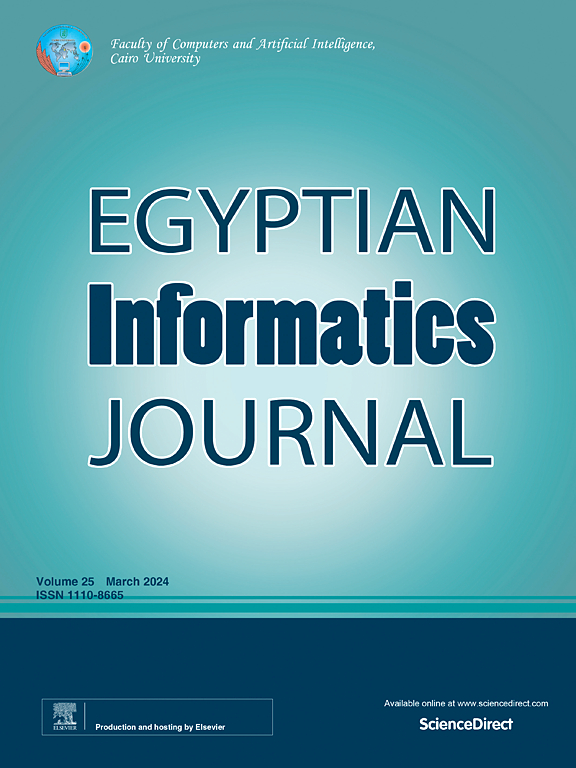Mechanical fault diagnosis based on combination of sparsely connected neural networks and a modified version of social network search
IF 5
3区 计算机科学
Q1 COMPUTER SCIENCE, ARTIFICIAL INTELLIGENCE
引用次数: 0
Abstract
Swift and precise fault diagnosis is a significant category to guarantee machinery operates reliably and avoid major failures. Conventional methods for monitoring bearing health rely on large datasets of labeled faulty samples, which can be time-consuming and costly to gain. Intelligent fault identification techniques are limited by a lack of defective samples. Although Convolutional Neural Networks (CNNs) are effective tools for diagnosing mechanical faults, they may perform poorly on unseen data due to overfitting when trained with few faulty samples. The small sample problem poses a significant difficulty in mechanical fault diagnosis, as insufficient faulty samples can induce overfitting in models such as CNNs that leads to inadequate generalization. For instance, conventional CNNs may extremely adapt to the unique traits of limited training data, whereas SCNNs, characterized by their sparse connectivity, reduce this concern. Additionally, optimizing the hyperparameters of SCNNs can be complex. However, the M-SNS algorithm, using Lévy flight and self-adjusting population mechanisms proficiently solves this issue by enhancing exploitation and exploration. This study suggests a novel approach to solve the small sample problem Sparsely Connected Neural Networks (SCNNs) enhanced by optimizing its hyperparameters based on an improved version of Social Network Search (M-SNS). While standard SNS-based optimizers struggle with local optima, the improved version incorporates Lévy flight to meaningly improve global search performance, guaranteeing better generalization even in small sample scenarios. The proposed SCNN/M-SNS is employed to use a tool for the fault diagnosis. To guarantee the efficiency of the model, its results are applied to a benchmark, called Case Western Reserve University (CWRU) Bearing Dataset which includes a flexible test rig with a 2 hp motor to simulate various load conditions (0, 1, 2, and 3 hp) and controlled fault introduction using Electrical Discharge Machining (EDM) to precisely introduce faults in bearings with different diameters (7, 14, 28, and 40 mils) and at different locations (roller, inner, and outer race faults). Accelerometers are used to collect data at two sampling rates (12 kHz and 48 kHz). The results are compared with some similar state of the art models based on SCNN, including fuzzy neural network model (FNN), Convolution Neural Network (CNN), and LSTM neural network. The results show that the proposed model achieves a mean squared error (MSE) of 0.021 on the test dataset which is higher than the fully connected network with an MSE of 0.035. When compared to other metaheuristic algorithms, the M-SNS-based SCNN model achieves an MSE of 0.021, while Genetic Algorithms (GA) and Particle Swarm Optimization (PSO) achieve MSE values of 0.023 and 0.025, respectively. The proposed model also outperforms other techniques on the CWRU dataset, with a classification accuracy of 98.2 %, compared to 95.5 % for CNN, 94.3 % for LSTM, and 90.1 % for FNN. These results demonstrate the effectiveness of the proposed model in fault diagnosis, particularly in scenarios with limited training data.
基于稀疏连接神经网络和改进版社会网络搜索相结合的机械故障诊断
快速、准确的故障诊断是保证机械可靠运行、避免重大故障的重要手段。监测轴承健康状况的传统方法依赖于标记故障样本的大型数据集,这可能耗时且成本高昂。智能故障识别技术受到缺陷样本缺乏的限制。虽然卷积神经网络(cnn)是诊断机械故障的有效工具,但当故障样本较少时,由于过度拟合,卷积神经网络在未见数据上的表现可能较差。小样本问题给机械故障诊断带来了很大的困难,因为故障样本不足会导致cnn等模型的过拟合,从而导致泛化不足。例如,传统cnn可能非常适应有限训练数据的独特特征,而scnn以其稀疏连接为特征,减少了这种担忧。此外,优化超参数的scnn可能是复杂的。而M-SNS算法利用lsamvy飞行和自调节种群机制,通过加强开发和探索,熟练地解决了这一问题。本研究提出了一种新的方法来解决基于改进版本的社交网络搜索(M-SNS),通过优化其超参数来增强稀疏连接神经网络(SCNNs)的小样本问题。当标准的基于社交网络的优化器与局部最优器斗争时,改进的版本结合了lsamvy飞行来有意义地提高全局搜索性能,即使在小样本场景中也能保证更好的泛化。采用所提出的SCNN/M-SNS作为故障诊断工具。为了保证模型的有效性,其结果被应用于一个基准,称为凯斯西储大学(CWRU)轴承数据集,该数据集包括一个带有2马力电机的灵活试验台,用于模拟各种负载条件(0,1,2和3马力),并使用电火花加工(EDM)控制故障引入,以精确地引入不同直径(7,14,28和40密尔)和不同位置(滚子,内圈和外圈故障)的轴承故障。加速度计用于以两种采样率(12 kHz和48 kHz)收集数据。结果与基于SCNN的模糊神经网络模型(FNN)、卷积神经网络(CNN)和LSTM神经网络等类似的最新模型进行了比较。结果表明,该模型在测试数据集上的均方误差(MSE)为0.021,高于全连接网络的均方误差(MSE) 0.035。与其他元启发式算法相比,基于m - sns的SCNN模型的MSE为0.021,而遗传算法(GA)和粒子群优化(PSO)的MSE分别为0.023和0.025。该模型在CWRU数据集上也优于其他技术,分类准确率为98.2%,而CNN为95.5%,LSTM为94.3%,FNN为90.1%。这些结果证明了该模型在故障诊断中的有效性,特别是在训练数据有限的情况下。
本文章由计算机程序翻译,如有差异,请以英文原文为准。
求助全文
约1分钟内获得全文
求助全文
来源期刊

Egyptian Informatics Journal
Decision Sciences-Management Science and Operations Research
CiteScore
11.10
自引率
1.90%
发文量
59
审稿时长
110 days
期刊介绍:
The Egyptian Informatics Journal is published by the Faculty of Computers and Artificial Intelligence, Cairo University. This Journal provides a forum for the state-of-the-art research and development in the fields of computing, including computer sciences, information technologies, information systems, operations research and decision support. Innovative and not-previously-published work in subjects covered by the Journal is encouraged to be submitted, whether from academic, research or commercial sources.
 求助内容:
求助内容: 应助结果提醒方式:
应助结果提醒方式:


